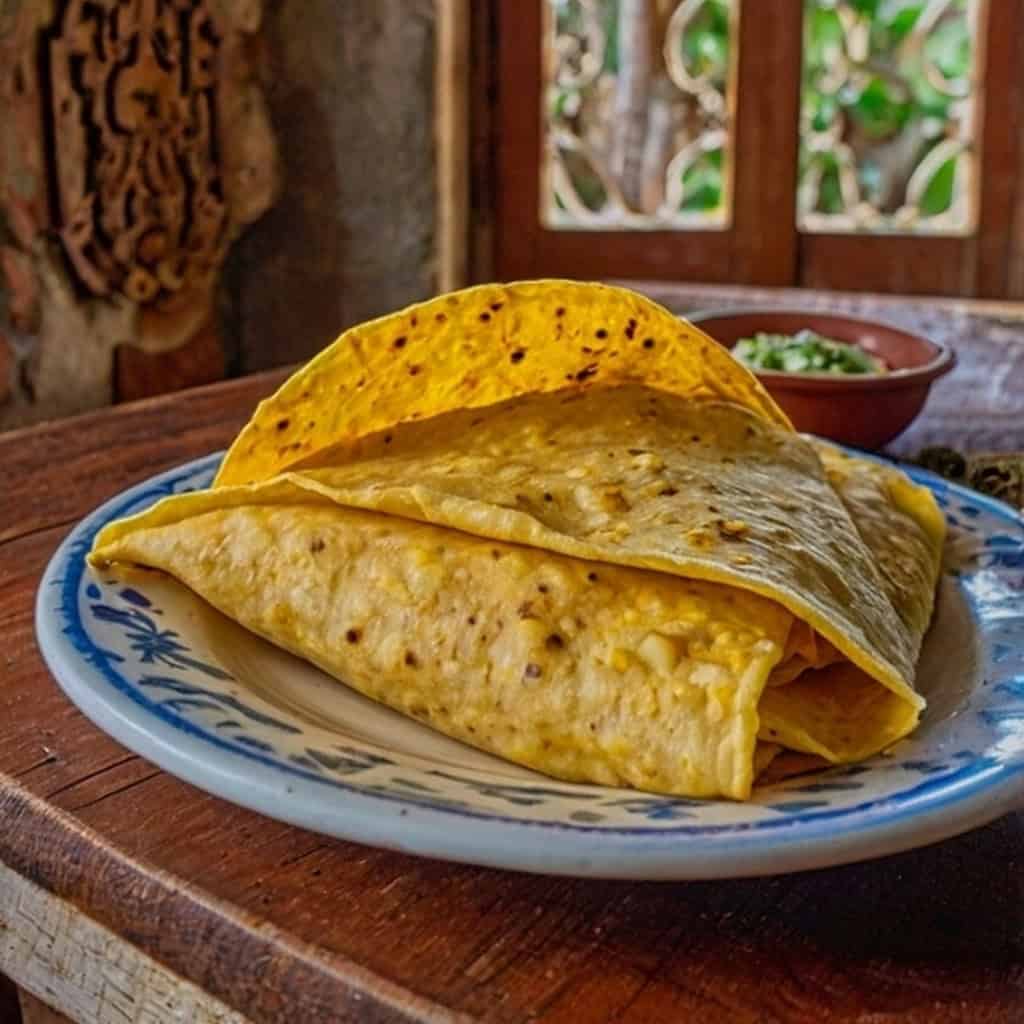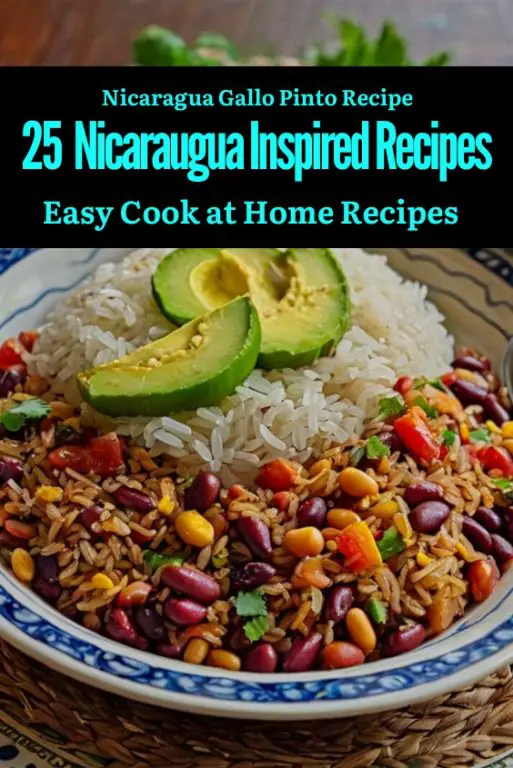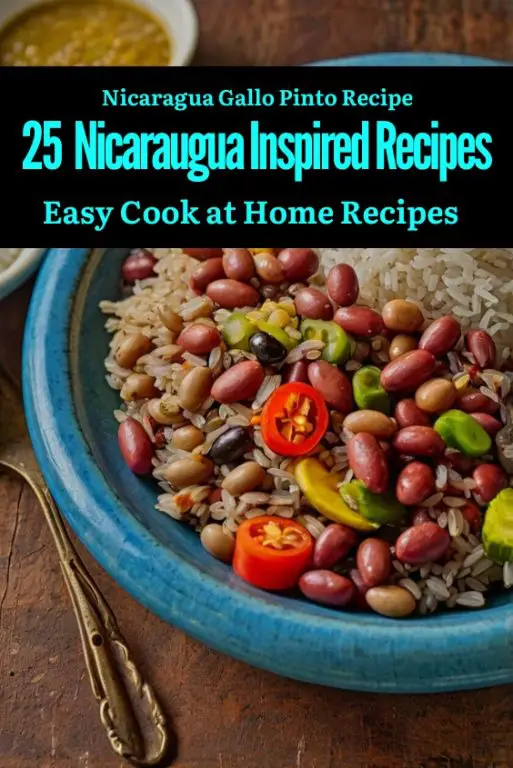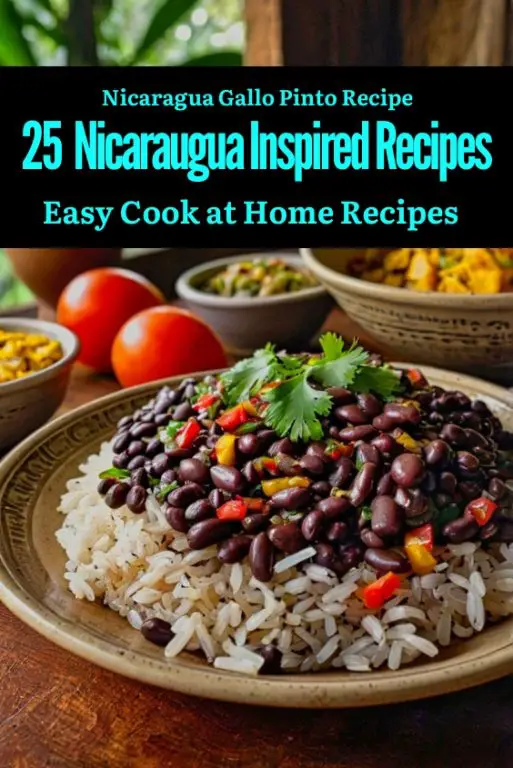Gallo Pinto is a traditional dish I have learned to love in my travels through Nicaraguan cuisine. This mix of rice and beans represents Nicaragua’s culinary heritage. Gallo Pinto was recommended to me by a dear Nicaraguan friend and I found it simple in ingredients but complex in taste. This hearty dish is sure to fill your belly.
I have my ingredients gathered so I can begin to cook. First I warm the vegetable oil in a medium sized skillet on moderate heat. If the oil is hot, I add the sliced onions and bell peppers. I saute them till they’re aromatic and soft, usually 5-7 minutes. After that I put in the finely chopped garlic and cook for one more minute, letting the garlicky scent fill my kitchen. What makes Gallo Pinto so special is that it combines aromatic ingredients to make a base for the dish that is soulful.
After that I put in the cooked rice and add in the sauteed vegetables. Break up any clumps of rice to make sure everything mixes evenly. Then come the black beans and Worcestershire sauce. If you used canned beans, drain and rinse them first. I fold everything together so it is equally distributed and the rice absorbs the flavors of the beans and seasonings.
I season the mix with pepper and salt to taste as it cooks and let it simmer for about 10 minutes. I give it a stir halfway through to prevent it from sticking. Here the goal is blending flavors without sacrificing the individuality of each ingredient. The dish should puff up slightly and form a pretty, colorful shape.
Ingredients For the Nicaraguan Galo Pinto
Cooked Rice
Cooked Black Beans
Finely Chopped Onion, finely chopped
Finely Chopped Green Bell Pepper, finely chopped
Minced Cloves Garlic, minced
Vegetable Oil
Ground Cumin
Salt
Pepper
Chopped Cilantro,
Sliced Avocado,
Fried Plantains
Cooking Instructions For the Nicaraguan Galo Pinto
- In a large pan or skillet, heat the vegetable oil over medium heat.
- Add the chopped onion, bell pepper, and minced garlic to the pan. Sauté until the vegetables are softened and lightly browned.
- Add the cooked black beans to the pan and stir well to combine with the vegetables. Cook for a few minutes to heat the beans through.
- dd the cooked rice to the pan, along with the ground cumin, salt, and pepper. Stir everything together until well combined and heated through.
- Continue cooking the mixture for a few more minutes, stirring occasionally to prevent sticking or burning.
- Remove the pan from heat and garnish with chopped cilantro, sliced avocado, or fried plantains if desired.
- Serve the Gallo Pinto warm as a main dish or as a side dish with your favorite accompaniments.
Foods Most Eaten by Nicaraguan Locals
Nicaraguan cuisine is deeply rooted in the country’s farming traditions and nearly all foods eaten reflect a combination of indigenous, Spanish and Creole foods. Among the staple meals in Nicaragua is gallo pinto an easy but flavorful dish of rice and red beans eaten for breakfast, lunch or even dinner. It’s usually paired with eggs, cheese, tortillas, or meat. It’s a staple meal in the Nicaraguan diet and is loved because of its affordability and versatility.
Yet another well known Nicaraguan dish is Vigor’n eaten on the street. It consists of boiled yucca topped with a cabbage slaw and chicharrones (fried pork skin). This filling meal is known for its texture: yucca goes with the crunch of pork and the crispiness of slaw. It is generally eaten on the run and served in banana leaves.
Nacatamales Nicaragua’s version of tamales, are popular. They’re big, steamy balls of dough made from ground corn stuffed with pork or chicken, potatoes, rice, and spices and rolled in banana leaves. Nacatamales are typically eaten on weekends or on special occasions but are still a staple comfort food for many Nicaraguans.
Yucca, plantains and corn are the basic ingredients of Nicaraguan cuisine. Fried plantains sliced thin (tostones) or mashed and fried (tajadas) are frequently served as a side dish or snack. Another popular street food is quesillo a tortilla stuffed with soft cheese, onions and cream.
For dessert, locals often have tres leches cake a sponge cake soaked in 3 types of milk: evaporated milk, condensed milk, and cream. Its sweet, moist texture causes it to be a favorite treat for celebrations.
Overall, foods eaten by Nicaraguan locals reflect the country’s staple usage of rice, beans, corn and plantains along with local produce and meats. Whether it’s street food or home cooked meals, Nicaraguan cuisine reflects its land and cultural past.
5 Essiential Ingredients for Nicaraguan Food
Nicaraguan cuisine, with its blend of indigenous, Spanish, and Creole influences, is deeply rooted in the country’s geography and agricultural abundance. Many traditional Nicaraguan dishes feature hearty, natural ingredients that are often locally sourced and used in a variety of ways. Below are five essential ingredients that form the backbone of Nicaraguan food:
1. Corn (Maíz)
Corn is a foundational ingredient in Nicaraguan cuisine, reflecting the influence of indigenous Mesoamerican cultures. It is not only a staple food but also plays a cultural and symbolic role. Corn is used in a variety of dishes, from tortillas and tamales to beverages like pinolillov and atol. Nicaraguan tortillas, made from ground corn dough (masa), are typically thicker than those found in neighboring countries. Nacatamales, a popular traditional dish, uses corn masa to encase a filling of meat, rice, and vegetables, wrapped in banana leaves and steamed. The versatility of corn in both savory and sweet dishes highlights its importance in Nicaraguan cooking, making it indispensable.
2. Rice and Beans (Arroz y Frijoles)
Rice and beans, particularly in the form of gallo pinto, are central to the Nicaraguan diet. Gallo pinto is made by mixing pre-cooked rice with red or black beans, sautéed with onions, garlic, and bell peppers, often cooked in the same oil in which the beans were fried. This dish is typically served for breakfast, lunch, or dinner, often alongside eggs, cheese, plantains, or meat. Rice and beans also appear in other dishes, such as arroz a la valenciana (a Nicaraguan version of paella) and various soups and stews, underscoring their role as a nutritional and flavorful base in Nicaraguan cuisine.
3. Plantains (Plátanos)
Plantains, a starchy fruit similar to bananas, are another essential ingredient in Nicaraguan cooking. They are used in many forms, depending on their ripeness. Green plantains are often sliced thin and fried to make tostones or mashed and fried to create tajadas, both popular side dishes. Ripe plantains, which are sweeter, are also fried or baked and can be served as a dessert. Plantains accompany many main dishes, such as grilled meats or gallo pinto, adding a hearty, satisfying component to meals. They are particularly valued for their ability to provide energy and texture, whether in savory or sweet applications.
4. Yucca (Yuca)
Yucca, or cassava, is a root vegetable widely consumed in Nicaragua. It is often boiled and served as a side dish or fried for a crispier texture. Yucca is a key component of the famous Nicaraguan dish vigorón, which consists of boiled yucca topped with a cabbage slaw and chicharrones (fried pork skin). This dish is popular as a street food and often served in banana leaves, adding to its appeal. Yucca’s starchy, mild flavor makes it a versatile ingredient in both traditional and modern Nicaraguan cooking. It is also used in stews and soups, such as sopa de res (beef soup), adding a hearty texture to these dishes.
5. Cheese (Queso)
Cheese plays a crucial role in many Nicaraguan meals, particularly in dishes like quesillo and as a complement to other main courses. Nicaraguan cheese, such as queso seco (a crumbly, salty cheese) and queso fresco (a softer, milder cheese), is typically served with tortillas or fried plantains. Quesillo, one of Nicaragua’s favorite street foods, features a tortilla filled with soft cheese, onions, and sour cream, often eaten on the go. Cheese is also incorporated into breakfast dishes, served with eggs or gallo pinto, making it a staple for many Nicaraguan families.
Nicaraguan cuisine is built on simple yet flavorful ingredients that reflect the country’s rich agricultural heritage and cultural diversity. Corn, rice and beans, plantains, yucca, and cheese are the building blocks of many traditional dishes, each playing a vital role in providing nourishment and flavor. These ingredients are versatile, used in a wide range of preparations that showcase the unique blend of indigenous and European influences found in Nicaraguan food. Whether in everyday meals or festive occasions, these essential ingredients continue to define the Nicaraguan culinary experience.
FAQ For the Nicaraguan Galo Pinto
Q: What type of rice is best for a Nicaraguan Gallo Pinto recipe?
A: For a Nicaraguan Gallo Pinto recipe, long-grain white rice is typically used due to its light and fluffy texture. The rice needs to be cooked properly, as it will be mixed with beans and other ingredients. Some people use leftover rice, which works well since it’s slightly drier and absorbs flavors more efficiently. The type of rice used can impact the texture, but the Nicaraguan Gallo Pinto recipe is versatile enough to work with different varieties.
Q: Can you add meat to a Nicaraguan Gallo Pinto recipe?
A: While a traditional Nicaraguan Gallo Pinto recipe is vegetarian, some people like to add meat for extra protein. Popular additions include shredded chicken, beef, or pork. If you choose to add meat, it’s typically cooked separately and then mixed in with the beans and rice. Though meat is not part of the classic Nicaraguan Gallo Pinto recipe, it can add a heartier element to the dish.
Q: What is the difference between a Costa Rican and a Nicaraguan Gallo Pinto recipe?
A: Both the Costa Rican and Nicaraguan Gallo Pinto recipes share similarities, as they use rice and beans as the base. However, the Nicaraguan Gallo Pinto recipe typically includes red beans, while the Costa Rican version uses black beans. In addition, the seasoning and side dishes can vary, with each country adding its own flair. The Nicaraguan Gallo Pinto recipe often has a more robust, earthy flavor thanks to the use of additional spices.
Q: How do you store leftovers of a Nicaraguan Gallo Pinto recipe?
A: Leftovers of a Nicaraguan Gallo Pinto recipe can be stored in an airtight container in the refrigerator for up to four days. It is easy to reheat in a pan or microwave, making it a convenient option for meal prep. When reheating, adding a splash of water or oil can help restore the texture. The Nicaraguan Gallo Pinto recipe holds up well over time, making it a great dish for leftovers.
Q: Can you use brown rice in a Nicaraguan Gallo Pinto recipe?
A: Yes, you can use brown rice in a Nicaraguan Gallo Pinto recipe, though it will change the texture slightly. Brown rice is more firm and has a nutty flavor, which may alter the overall taste of the dish. However, it’s a healthy alternative and works well if cooked properly. A Nicaraguan Gallo Pinto recipe with brown rice can provide more fiber and nutrients while still maintaining its hearty and delicious qualities.

Nicaraguan Gallo Pinto Recipe
Ingredients
- 2 cups cooked rice
- 2 cups cooked black beans
- 1 onion finely chopped
- 1 green bell pepper finely chopped
- 3 cloves garlic minced
- 2 tablespoons vegetable oil
- 1 teaspoon ground cumin
- Salt and pepper to taste
- Optional garnishes: chopped cilantro sliced avocado, fried plantains
Equipment
- Large pan or skillet: Used to sauté the vegetables, combine the beans and rice, and heat the Gallo Pinto.
Instructions
- In a large pan or skillet, heat the vegetable oil over medium heat.
- Add the chopped onion, bell pepper, and minced garlic to the pan. Sauté until the vegetables are softened and lightly browned.
- Add the cooked black beans to the pan and stir well to combine with the vegetables. Cook for a few minutes to heat the beans through.
- Add the cooked rice to the pan, along with the ground cumin, salt, and pepper. Stir everything together until well combined and heated
- through.
- Continue cooking the mixture for a few more minutes, stirring occasionally to prevent sticking or burning.
- Remove the pan from heat and garnish with chopped cilantro, sliced avocado, or fried plantains if desired.
- Serve the Gallo Pinto warm as a main dish or as a side dish with your favorite accompaniments.
Notes
If you prefer a spicier Gallo Pinto, you can add chopped jalapeños or a dash of hot sauce.





1 comment
The combination of rice and beans cooked together made for a hearty meal that paired perfectly with eggs for breakfast. The seasoning was mild but rich, and it reminded me of similar comfort foods. I appreciate how easy it was to prepare with basic ingredients.